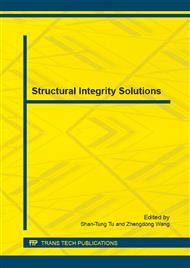p.266
p.272
p.279
p.285
p.295
p.307
p.316
p.324
p.330
Structural Integrity Role in Plant Life Extension - A Case Study
Abstract:
The steam generators at Advanced Gas-Cooled Reactor (AGR) nuclear power stations in the UK are potentially life-limiting components. Enhancing the capability to monitor the steam generators has been identified as having the potential to provide key evidence in justifying the extension of the generating lifetime of the stations. It has been proposed to install new temperature measuring instrumentation to monitor reactor gas temperature and to provide additional data regarding steam generator operating conditions. The modification will be to introduce thermocouples to the bore of an intact steam generator tube to facilitate temperature measurement at or near to the locations of interest. The modified steam generator tube will be sealed at the feed header upstand. Between the upper surface of the superheater header tubeplate and the wall of the superheater header, the thermocouple bundle and sheath will be contained within a rigid stainless steel guide tube. The guide tube will be attached at both ends by welds, each forming a pressure boundary. At the tubeplate a weld will separate the bore of the sealed guide tube from the steam space within the superheater header; a weld between the guide tube and the superheater header will separate the steam space within the superheater header from atmosphere outside the header. In order to obtain a better design, three 3-dimentional finite element models have been created using ABAQUS. A series of cyclic pressure, and start-up and shutdown thermal transient stress analyses have been carried out to provide stress values for structural integrity assessments to be conducted using ASME III, Subsection NH and R5.
Info:
Periodical:
Pages:
295-306
Citation:
Online since:
April 2015
Authors:
Price:
Сopyright:
© 2015 Trans Tech Publications Ltd. All Rights Reserved
Share:
Citation:


